A research scholar get a mixture of three product during an experiment with ammonia. In product I only one H of ammonia is replaced by ethyl group and in II two H atoms of ammonia are replaced by ethyl groups and in III all the H- atoms are replaced by ethyl groups. Which test he should use to distinguish or separate the products :
Carbyl amine test
Iodoform test
Fehling solution test
Hinsbert test
The correct Answer is:D
1∘,2∘ and 3∘ amine mixture can be separated by Hinsberg reagent.
Topper's Solved these Questions
- STRUCTURAL IDENTIFICATION & PRACTICAL ORGANIC CHEMISTRYBOOK - RESONANCE ENGLISHCHAPTER - STRUCTURAL IDENTIFICATION & PRACTICAL ORGANIC CHEMISTRYEXERCISE - Part-III
27 Videos
- STRUCTURAL IDENTIFICATION & PRACTICAL ORGANIC CHEMISTRYBOOK - RESONANCE ENGLISHCHAPTER - STRUCTURAL IDENTIFICATION & PRACTICAL ORGANIC CHEMISTRYEXERCISE - Additional theory
4 Videos
- STRUCTURAL IDENTIFICATION & PRACTICAL ORGANIC CHEMISTRYBOOK - RESONANCE ENGLISHCHAPTER - STRUCTURAL IDENTIFICATION & PRACTICAL ORGANIC CHEMISTRYEXERCISE - Jee main
6 Videos
- SOLID STATEBOOK - RESONANCE ENGLISHCHAPTER - SOLID STATEEXERCISE - Part- IV
21 Videos
- THERMODYNAMIC & THERMOCHEMISTRYBOOK - RESONANCE ENGLISHCHAPTER - THERMODYNAMIC & THERMOCHEMISTRYEXERCISE - INORGANIC CHEMISTRY(P-Block Elements)
26 Videos
Similar Questions
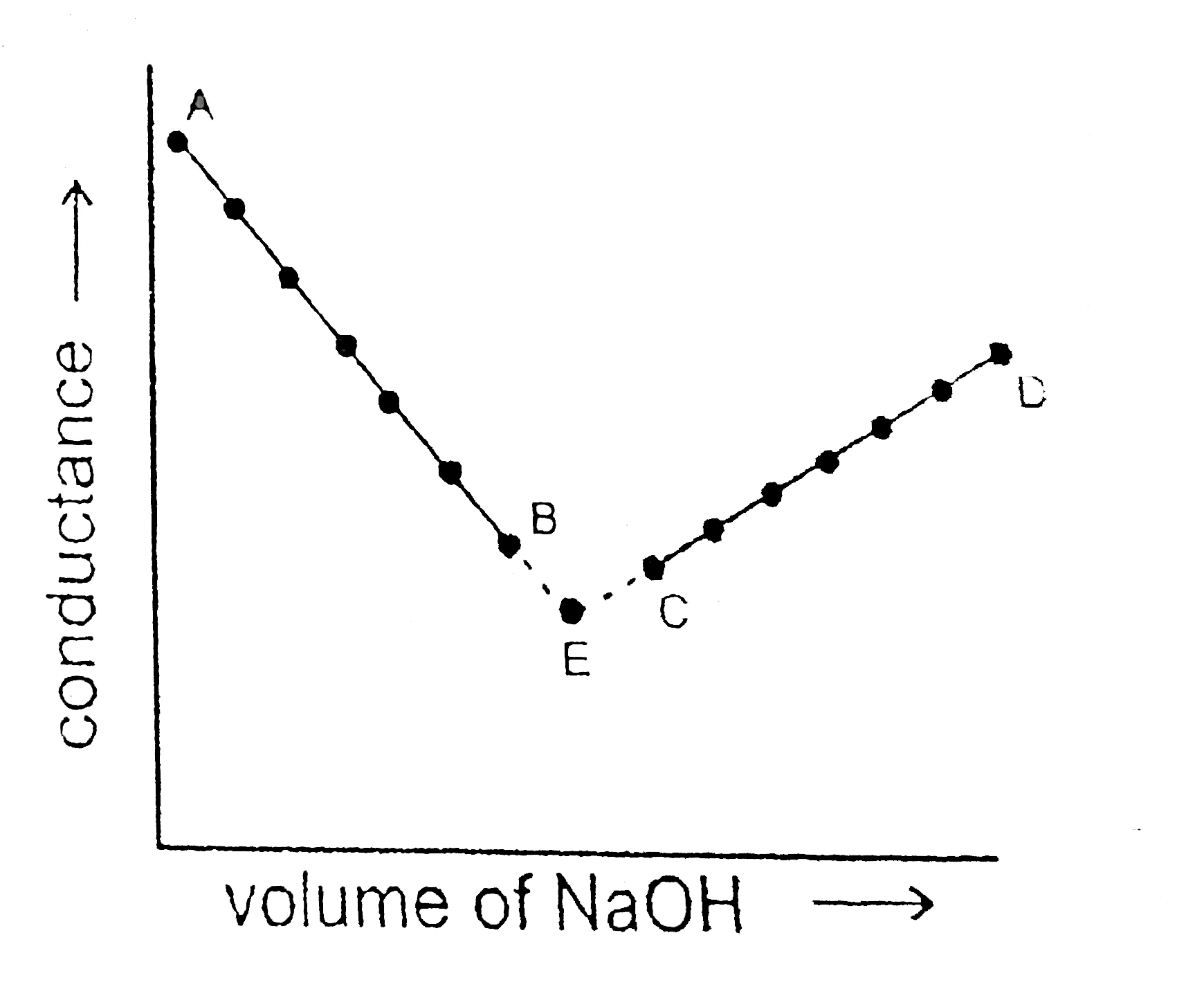
Strong acid versus strong base:
The principle of conductometric titrations is based on the fact that during the titration, one of the ions is replaced by the other and invariable these two ions differ in the ionic conductivity with the result that thhe conductivity of the solution varies during the course of the titration. take, for example, the titration between a strong acid, say HCl, and a string base, say NaOH before NaOH is added, the conductance of HCl solution has a high value due to the presence of highly mobile hydrogen ions. As NaOH is added, H+ ions are replaced by relatively slower moving Na+ ions. consequently the conductance of the solution decreases and this continues right upto the equivalence point where the solution contains only NaCl. Beyond the equivalence point, if more of NaOH is added, then the solution contains a excess of the fast moving OH− ions with the result that its conductance is increased ad it condinues to increase as more and more of NaOH is added. If we plot the conductance value versus the amount of NaOH added, we get a curve of the type shown in Fig. The descending portion AB represents the conductances before the equivalence point (solution contains a mixture of acid HCl and the salt NaCl) and the ascending portion CD represents the conductances after the equivalence point (solution contains the salt NaCl and the excess of NaOH). The point E which represent the minium conductance is due to the solution containing only NaCl with no free acid or alkali and thus represents the equivalence point. this point can, however, be obtained by the extrapolation of the lines AB and DC, and therefore, one is not very particular in locating this point expermentally as it is in the case of ordinary acid-base titrations involving the acid-base indicators.
Weak acid versus strong base:
Let us take specific example of acetic acid being titrated against NaOH. Before the addition of alkali, the solution shows poor conductance due to feeble ionization of acetic acid. Initially the addition of alkali causes not only the replacement of H+ by Na+ but also suppresses the dissociation of acetic acid due to the common ion Ac− and thus the conductance of the solution decreases in the beginning. but very soon the conductance start increasing as addition of NaOH neutralizes the undissociated HAc to Na+Ac− thus causing the replacement of non-conducting HAc with Strong-conducting electrolyte Na+Ac−. the increase in conductance continuous right up to the equivalence point. Beyond this point conductance increases more rapidly with the addition of NaOH due to the highly conducting OH− ions, the graph near the equivalence point is curved due to the hydrolysis of the salt NaAc. The actual equivalence point can, as usual, be obtained by the extrapolation method.
In all these graphs it has been assumed that the volume change due addition of solution from burrette is negnigible, hence volume change of the solution in beaker the conductance of which is measured is almost constant throughout the measurement.
Q. The nature of curve obtained for the titration between weak acid versus strong base as described in the above passage will be:
View SolutionConsider a solution of CH3COONH4 which is a salt weak acid and weak base.
The equilibrium involved in the solutions are :
CH3COO−+H2O⇔CH3COOH+OH− ........(i)
NH+4+H2⇔NH4OH+H+ ........(ii)
H++OH−⇔H2O ........(iii)
If we add these reactions, then the net reaction is :
CH3COO−+H+2+H2O⇔CH3COOH+NH4OH ........(iv)
Both CH3COO−and NH+4 get hydrolysed independently and their hydrolysis depends on :
(a) their initial concentration
(b) The value of Kh which is KwKa for CH3COO− and KwKb for NH+4.
Since both of the ions were produced form the salt, their initial concertration are same. Therefore, unless and until the value of KwKa or Ka and Kb is same, the degree of hydrogen of ions can't be same.
To explain why we assume that degree of hydrolysis of cation and anion is same, we needed to now look at the third reaction i.e.,combination of H+ and OH− ions. It is obvious that this reaction happens only because one reaction produced H+ ion and the other prodcued OH− ions. We can also note that this reaction causes both the hydrolysis reaction to occur more since their product ions are being consumed. Keep this in mind that the equilibrium which has smaller value of the equilibrium constant is affected more by the common ion effect. For the same reason if for any reson a reaction is made to occur to a greater extent by the consumption of any of the prodcut ion, the reaction with the smaller value of equilibrium constant tends to get affected more.
Therefore, we conclude that firstly the hydroylsis of both the ions occurs more in the presence of each other (due to consumption of the product ions) than in each other's absence. Secondly,the hydroylsis of the ion which occurs to a lesser extent (due to smaller value of Kh)is affected more than the one whole Kh is greater. Hence we can see that the degree of hydroylsis of both the ions would be close to each other when they are getting hyderolysed in the presence of each other.
For 0.1 M CH3COONH4 salt solution given, Ka(CH3COOH)=Kb(NH4OH)=2×10−5.
In the case : degree of hydrolysis of cation and anion are :
View Solution
Knowledge Check
Cyclohexane exists its two chair conformations in rapid equilrium at room temperature.
Each carbon atom on a cyclohexane ring has one axial and one equatorial hydrogen. Ring-flipping converts axial II's to equatorial H's and vice-versa.
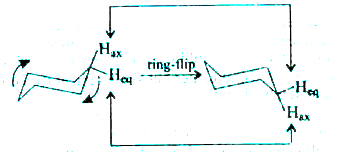
In substituted cyclohexane, groups larger than hydrogen are more stable in the equatorial position.
The cis isomer has two groups on the same side of the ring, either both up or both down.
The trans isomer has two groups on opposite side of the ring one up and one down.
Which of the following is most stable conformer of 1,2-dichlorocyclohexane?A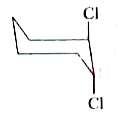 B
B C
C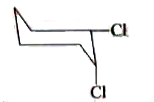 DAll have equal stability
DAll have equal stabilityMare understanding needs to be cultivated of the social process of organizations and, in particular, the role of one's own behaviour in the production and reproduction of organisational life. For it is true that management is too potent in its effects upon the lies of employees, consumers and citizens to be guided by an instrumental form of rationality. MBA programs strongly advise students on the importance of safeguarding their careers. Almost everything and everyone is seen as a stepping stone or an obstacle in realizing this end. In education and educational matters it helps to explicitly discuss the tendency people have of avoiding emotions or discussions on power problems and underlying dynamic processes. The thing that makes experimental learning so very valuable is not possible until there is no escape route left. Students and other participants in the programme will initially be opposed to expressing their emotions and will also feel ill at ease, but getting over this helps and facilitates their learning. Things do not have to be what they seem at first glance. Let me illustrate this. Two children are playing and they both fall into the mud. One of the children didn't get a dirty face and when he sees the soiled face of his friend, it is understandable that he should run inside to wash. The other, the one who actually is dirty and could do with a good wash, stays sitting there quietly. He didn't get a fright at all, after all, his friend looked the same as always. However, it is far less understandable if it is managers who become the unwitting prisoner of supposed Minstrumental" perception. The technical view of management practice can be criticized from both inside and outside). In the latter case, it is the attempt to dominate others which is criticized. (Looking at the instrumental apparatus from the inside, there is absolutely no proof that control techniques actually lead to the desired control. Drucker has already recognized that "control weakens control." In other words, even within one's own frame of reference, purely technical viewson management practice are not particularly moral or effective. An education plan which emphasizes that a manager will always be a tangible, approachable person have to leam to deal with the insecurity, doubts and mysteries. The lecture hall will often be a safer place than one's place of work of thinking, experimenting, testing, and questioning. It is good place to practice and to learn to be alert in everyday work situations. The role of management education is therefore inclusive, and is also concerned with accepting daily dilemmas, both moral and instrumental, and no longer believing that a technical approach can be neutral, even though it seems to be taught that way. The past 20 years, which have been characterized in the West by a modern neo-capitalistic political climate, have increasingly validated the usefulness of management education. On the one hand, education is considered as socially competitive. On the other hand, within the framework of an individualistic consumer culture, education is considered personally valuable in so far as it enhances the economic position and career of the individual. Business studies and management education score well on both criteria. However, this will remain true only if people continue to feel there is a positive relationship between management education, results in management practice, and managers' individual achievements.
Facilitates:AencourageBadvanceCpromotesDall of themMare understanding needs to be cultivated of the social process of organizations and, in particular, the role of one's own behaviour in the production and reproduction of organisational life. For it is true that management is too potent in its effects upon the lies of employees, consumers and citizens to be guided by an instrumental form of rationality. MBA programs strongly advise students on the importance of safeguarding their careers. Almost everything and everyone is seen as a stepping stone or an obstacle in realizing this end. In education and educational matters it helps to explicitly discuss the tendency people have of avoiding emotions or discussions on power problems and underlying dynamic processes. The thing that makes experimental learning so very valuable is not possible until there is no escape route left. Students and other participants in the programme will initially be opposed to expressing their emotions and will also feel ill at ease, but getting over this helps and facilitates their learning. Things do not have to be what they seem at first glance. Let me illustrate this. Two children are playing and they both fall into the mud. One of the children didn't get a dirty face and when he sees the soiled face of his friend, it is understandable that he should run inside to wash. The other, the one who actually is dirty and could do with a good wash, stays sitting there quietly. He didn't get a fright at all, after all, his friend looked the same as always. However, it is far less understandable if it is managers who become the unwitting prisoner of supposed Minstrumental" perception. The technical view of management practice can be criticized from both inside and outside). In the latter case, it is the attempt to dominate others which is criticized. (Looking at the instrumental apparatus from the inside, there is absolutely no proof that control techniques actually lead to the desired control. Drucker has already recognized that "control weakens control." In other words, even within one's own frame of reference, purely technical viewson management practice are not particularly moral or effective. An education plan which emphasizes that a manager will always be a tangible, approachable person have to leam to deal with the insecurity, doubts and mysteries. The lecture hall will often be a safer place than one's place of work of thinking, experimenting, testing, and questioning. It is good place to practice and to learn to be alert in everyday work situations. The role of management education is therefore inclusive, and is also concerned with accepting daily dilemmas, both moral and instrumental, and no longer believing that a technical approach can be neutral, even though it seems to be taught that way. The past 20 years, which have been characterized in the West by a modern neo-capitalistic political climate, have increasingly validated the usefulness of management education. On the one hand, education is considered as socially competitive. On the other hand, within the framework of an individualistic consumer culture, education is considered personally valuable in so far as it enhances the economic position and career of the individual. Business studies and management education score well on both criteria. However, this will remain true only if people continue to feel there is a positive relationship between management education, results in management practice, and managers' individual achievements.
EconomicAFreedom cannot exist apart from some amount of economic liberty.BThis graph shows political, economical and moral culture.CWe face severe disruptions, when we transit from one set of economic realities to another.DThe economic class in railways is divided into five styles.
Consider a solution of CH3COONH4 which is a salt weak acid and weak base.
The equilibrium involved in the solutions are :
CH3COO−+H2O⇔CH3COOH+OH− ........(i)
NH+4+H2⇔NH4OH+H+ ........(ii)
H++OH−⇔H2O ........(iii)
If we add these reactions, then the net reaction is :
CH3COO−+H+2+H2O⇔CH3COOH+NH4OH ........(iv)
Both CH3COO−and NH+4 get hydrolysed independently and their hydrolysis depends on :
(a) their initial concentration
(b) The value of Kh which is KwKa for CH3COO− and KwKb for NH+4.
Since both of the ions were produced form the salt, their initial concertration are same. Therefore, unless and until the value of KwKa or Ka and Kb is same, the degree of hydrogen of ions can't be same.
To explain why we assume that degree of hydrolysis of cation and anion is same, we needed to now look at the third reaction i.e.,combination of H+ and OH− ions. It is obvious that this reaction happens only because one reaction produced H+ ion and the other prodcued OH− ions. We can also note that this reaction causes both the hydrolysis reaction to occur more since their product ions are being consumed. Keep this in mind that the equilibrium which has smaller value of the equilibrium constant is affected more by the common ion effect. For the same reason if for any reson a reaction is made to occur to a greater extent by the consumption of any of the prodcut ion, the reaction with the smaller value of equilibrium constant tends to get affected more.
Therefore, we conclude that firstly the hydroylsis of both the ions occurs more in the presence of each other (due to consumption of the product ions) than in each other's absence. Secondly,the hydroylsis of the ion which occurs to a lesser extent (due to smaller value of Kh)is affected more than the one whole Kh is greater. Hence we can see that the degree of hydroylsis of both the ions would be close to each other when they are getting hyderolysed in the presence of each other.
In the hydrolysis of salt weak acid and weak base :
View SolutionNucleophilic aliphatic substitution reaction is mainly of two types: SN1 and SN2. The SN1 mechanism is a two step process. Reaction velocity of SN1 reaction depends only on the concentration of the substrate. Since product formation takes place by the formation of carbocation, optically active substrate gives (+) and (-) forms of the product. In most of the cases the product usually consits of 5−20% inverted product and 80−95% racemised species. The more stable the carbocation, the greater is the proportion of racemisation. In solvolysis reaction, the more nucleophilic the solvent, the greater is the proportion of inversion.
Which of the following compounds will give SN1 and SN2 reactions with considerable rate?
I. C6H5−CH2−Br (II) CH2=CH−CH2−Br (III) CH3−CH(Br)CH3 (IV)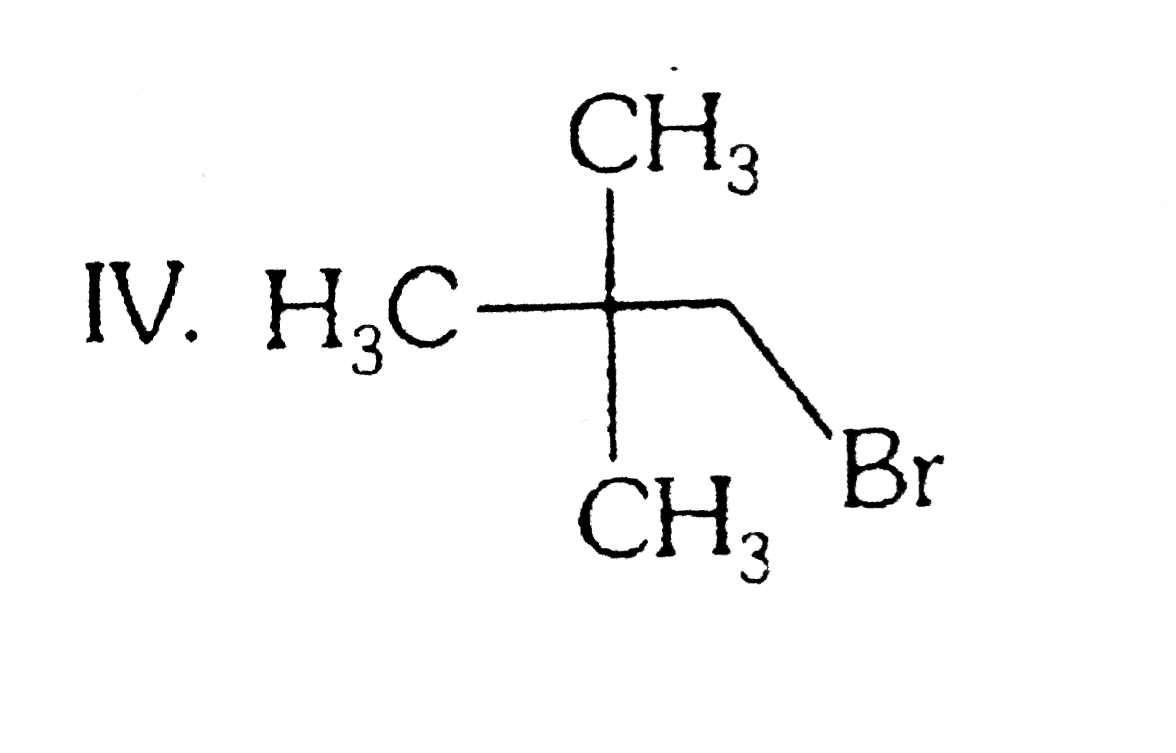
Select the correct answer from teh codes given below
View SolutionMare understanding needs to be cultivated of the social process of organizations and, in particular, the role of one's own behaviour in the production and reproduction of organisational life. For it is true that management is too potent in its effects upon the lies of employees, consumers and citizens to be guided by an instrumental form of rationality. MBA programs strongly advise students on the importance of safeguarding their careers. Almost everything and everyone is seen as a stepping stone or an obstacle in realizing this end. In education and educational matters it helps to explicitly discuss the tendency people have of avoiding emotions or discussions on power problems and underlying dynamic processes. The thing that makes experimental learning so very valuable is not possible until there is no escape route left. Students and other participants in the programme will initially be opposed to expressing their emotions and will also feel ill at ease, but getting over this helps and facilitates their learning. Things do not have to be what they seem at first glance. Let me illustrate this. Two children are playing and they both fall into the mud. One of the children didn't get a dirty face and when he sees the soiled face of his friend, it is understandable that he should run inside to wash. The other, the one who actually is dirty and could do with a good wash, stays sitting there quietly. He didn't get a fright at all, after all, his friend looked the same as always. However, it is far less understandable if it is managers who become the unwitting prisoner of supposed Minstrumental" perception. The technical view of management practice can be criticized from both inside and outside). In the latter case, it is the attempt to dominate others which is criticized. (Looking at the instrumental apparatus from the inside, there is absolutely no proof that control techniques actually lead to the desired control. Drucker has already recognized that "control weakens control." In other words, even within one's own frame of reference, purely technical viewson management practice are not particularly moral or effective. An education plan which emphasizes that a manager will always be a tangible, approachable person have to leam to deal with the insecurity, doubts and mysteries. The lecture hall will often be a safer place than one's place of work of thinking, experimenting, testing, and questioning. It is good place to practice and to learn to be alert in everyday work situations. The role of management education is therefore inclusive, and is also concerned with accepting daily dilemmas, both moral and instrumental, and no longer believing that a technical approach can be neutral, even though it seems to be taught that way. The past 20 years, which have been characterized in the West by a modern neo-capitalistic political climate, have increasingly validated the usefulness of management education. On the one hand, education is considered as socially competitive. On the other hand, within the framework of an individualistic consumer culture, education is considered personally valuable in so far as it enhances the economic position and career of the individual. Business studies and management education score well on both criteria. However, this will remain true only if people continue to feel there is a positive relationship between management education, results in management practice, and managers' individual achievements.
Cultivated:
View SolutionMare understanding needs to be cultivated of the social process of organizations and, in particular, the role of one's own behaviour in the production and reproduction of organisational life. For it is true that management is too potent in its effects upon the lies of employees, consumers and citizens to be guided by an instrumental form of rationality. MBA programs strongly advise students on the importance of safeguarding their careers. Almost everything and everyone is seen as a stepping stone or an obstacle in realizing this end. In education and educational matters it helps to explicitly discuss the tendency people have of avoiding emotions or discussions on power problems and underlying dynamic processes. The thing that makes experimental learning so very valuable is not possible until there is no escape route left. Students and other participants in the programme will initially be opposed to expressing their emotions and will also feel ill at ease, but getting over this helps and facilitates their learning. Things do not have to be what they seem at first glance. Let me illustrate this. Two children are playing and they both fall into the mud. One of the children didn't get a dirty face and when he sees the soiled face of his friend, it is understandable that he should run inside to wash. The other, the one who actually is dirty and could do with a good wash, stays sitting there quietly. He didn't get a fright at all, after all, his friend looked the same as always. However, it is far less understandable if it is managers who become the unwitting prisoner of supposed Minstrumental" perception. The technical view of management practice can be criticized from both inside and outside). In the latter case, it is the attempt to dominate others which is criticized. (Looking at the instrumental apparatus from the inside, there is absolutely no proof that control techniques actually lead to the desired control. Drucker has already recognized that "control weakens control." In other words, even within one's own frame of reference, purely technical viewson management practice are not particularly moral or effective. An education plan which emphasizes that a manager will always be a tangible, approachable person have to leam to deal with the insecurity, doubts and mysteries. The lecture hall will often be a safer place than one's place of work of thinking, experimenting, testing, and questioning. It is good place to practice and to learn to be alert in everyday work situations. The role of management education is therefore inclusive, and is also concerned with accepting daily dilemmas, both moral and instrumental, and no longer believing that a technical approach can be neutral, even though it seems to be taught that way. The past 20 years, which have been characterized in the West by a modern neo-capitalistic political climate, have increasingly validated the usefulness of management education. On the one hand, education is considered as socially competitive. On the other hand, within the framework of an individualistic consumer culture, education is considered personally valuable in so far as it enhances the economic position and career of the individual. Business studies and management education score well on both criteria. However, this will remain true only if people continue to feel there is a positive relationship between management education, results in management practice, and managers' individual achievements.
Management:
View SolutionMare understanding needs to be cultivated of the social process of organizations and, in particular, the role of one's own behaviour in the production and reproduction of organisational life. For it is true that management is too potent in its effects upon the lies of employees, consumers and citizens to be guided by an instrumental form of rationality. MBA programs strongly advise students on the importance of safeguarding their careers. Almost everything and everyone is seen as a stepping stone or an obstacle in realizing this end. In education and educational matters it helps to explicitly discuss the tendency people have of avoiding emotions or discussions on power problems and underlying dynamic processes. The thing that makes experimental learning so very valuable is not possible until there is no escape route left. Students and other participants in the programme will initially be opposed to expressing their emotions and will also feel ill at ease, but getting over this helps and facilitates their learning. Things do not have to be what they seem at first glance. Let me illustrate this. Two children are playing and they both fall into the mud. One of the children didn't get a dirty face and when he sees the soiled face of his friend, it is understandable that he should run inside to wash. The other, the one who actually is dirty and could do with a good wash, stays sitting there quietly. He didn't get a fright at all, after all, his friend looked the same as always. However, it is far less understandable if it is managers who become the unwitting prisoner of supposed Minstrumental" perception. The technical view of management practice can be criticized from both inside and outside). In the latter case, it is the attempt to dominate others which is criticized. (Looking at the instrumental apparatus from the inside, there is absolutely no proof that control techniques actually lead to the desired control. Drucker has already recognized that "control weakens control." In other words, even within one's own frame of reference, purely technical viewson management practice are not particularly moral or effective. An education plan which emphasizes that a manager will always be a tangible, approachable person have to leam to deal with the insecurity, doubts and mysteries. The lecture hall will often be a safer place than one's place of work of thinking, experimenting, testing, and questioning. It is good place to practice and to learn to be alert in everyday work situations. The role of management education is therefore inclusive, and is also concerned with accepting daily dilemmas, both moral and instrumental, and no longer believing that a technical approach can be neutral, even though it seems to be taught that way. The past 20 years, which have been characterized in the West by a modern neo-capitalistic political climate, have increasingly validated the usefulness of management education. On the one hand, education is considered as socially competitive. On the other hand, within the framework of an individualistic consumer culture, education is considered personally valuable in so far as it enhances the economic position and career of the individual. Business studies and management education score well on both criteria. However, this will remain true only if people continue to feel there is a positive relationship between management education, results in management practice, and managers' individual achievements.
Face:
View Solution
